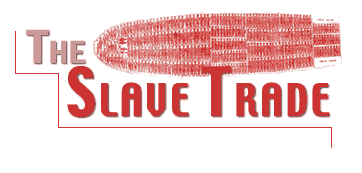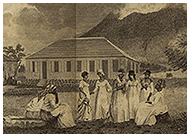 | 
 |
After the horrendous sea voyage from Africa, slaves were separated and placed on plantations in the West Indies. These slaves, already disoriented, were now forced into a brutal life of labor and surveillance. Day after day, the Africans cultivated crops, tended to animals, and served their "owners" in any way possible. Sixteen to eighteen hours of work was the norm on most West Indian plantations, and during the season of sugarcane harvest, most slaves only got four hours of sleep. The punishment for disobeying an order was far worse than just accepting what was asked. This treatment of the slaves created anger and hatred towards the white plantation owners, feelings that the slaves could vent in only one way: resistance. Yet for resistance to succeed, the slaves needed to share some common values. Those slaves who were able to convert to Christianity were able to create such a bond through a common religion. In turn, this unity served as a way to resist the atrocities the plantation owners imposed on them. Thus, for many slaves, Christianization served as a means of resistance throughout the period of the slave trade.
 Before the establishment of Christianity in the West Indies, slaves looked to their own system of belief, brought from their individual African tribal communities. The African religions were religions of spirit, not of doctrine. At the same time, most African religions believed in the existence of one supreme god. This belief, shared with Christianity, made it easier for Africans to understand the Christian religion. African religious beliefs held that spirits of ancestors and natural phenomena immediately affected people’s lives. Their religion saw man himself as, essentially, a spirit. Death rites were important to ascertain that the spirit of the departed remained benign rather than hostile to those left behind. However, African religions did not offer an idea of heaven, and this too attracted many slaves towards Christianity. For many, heaven promised a reward for suffering in the physical world. Before the establishment of Christianity in the West Indies, slaves looked to their own system of belief, brought from their individual African tribal communities. The African religions were religions of spirit, not of doctrine. At the same time, most African religions believed in the existence of one supreme god. This belief, shared with Christianity, made it easier for Africans to understand the Christian religion. African religious beliefs held that spirits of ancestors and natural phenomena immediately affected people’s lives. Their religion saw man himself as, essentially, a spirit. Death rites were important to ascertain that the spirit of the departed remained benign rather than hostile to those left behind. However, African religions did not offer an idea of heaven, and this too attracted many slaves towards Christianity. For many, heaven promised a reward for suffering in the physical world.
While some West Indian slaves opposed European Christianity, many more would eventually come to adopt and adapt at least some of its elements. Missionaries from the Moravians, the Baptists, and the Methodists all engaged in the process of Christianization in the West Indies. By the middle of the eighteenth century, Moravian chapels and mission houses were in populated areas of many of the British-controlled islands. Missionaries argued to planters that slaves needed religion and that planters too would benefit from the conversion.
However, many planters felt that the conversion of their slaves would jeopardize their own position of power. Richard Ligon’s firsthand account of planter life in the West Indies reveals evidence of this feeling as early as the mid-eighteenth century. His account, A True and Exact History of the island of Barbados, contains a passage where Ligon is speaking to a planter about his wishes to convert one of the planters slaves (Sambo) to Christianity.
 "I promised to do my best endeavor; and when I came home, spoke to the master of the plantation, and told him, that poor Sambo desired much to be a Christian. But his answer was, ‘The people of the island are governed by the laws of England, and by those laws, we could not make a Christian a slave. I told him, ‘My request was far different from that, for I desired to make a slave a Christian.’ His answer was, ‘That it was true, There was a great difference in that,’: But, being once a Christian, he could no more account him a slave, and so lose the hold they had of them as slaves, by making them Christians; and by that means should open such a gap, as all the planters in the island would curse him. So I was struck mute, and poor Sambo kept out of the Church." "I promised to do my best endeavor; and when I came home, spoke to the master of the plantation, and told him, that poor Sambo desired much to be a Christian. But his answer was, ‘The people of the island are governed by the laws of England, and by those laws, we could not make a Christian a slave. I told him, ‘My request was far different from that, for I desired to make a slave a Christian.’ His answer was, ‘That it was true, There was a great difference in that,’: But, being once a Christian, he could no more account him a slave, and so lose the hold they had of them as slaves, by making them Christians; and by that means should open such a gap, as all the planters in the island would curse him. So I was struck mute, and poor Sambo kept out of the Church."
The planters who opposed the conversion of their slaves feared the possibilities of a Christianized slave, and resented the idea of sharing their religion with a heathen. During the era of the slave trade, many whites claimed that slaves were not capable of understanding Christianity. However, many were afraid that if their slaves received education they would demand their rights as human beings. For slaves to be kept in bondage, they needed to be kept in ignorance. And so, many planters believed that the teaching of Christianity would undermine the whole institution of slavery. The planters who were cruel and barbarous towards their slaves feared conversion the most. They feared the vengeance of their slaves if a revolt were to take place. Those who lived in the West Indies had witnessed the Haitian Revolution where the white French population on the island had been wiped out by rebelling blacks. The planters feared that this could happen on their island if slaves were given the notion of equality through religion, or the promise that eternal life awaited those martyred to the cause of freedom and equality on earth.
Many planters who opposed conversion also did so because they resented missionaries. Christianized slaves sometimes looked to white missionaries for protection when their master was angry with them. Female slaves in particular faced sexual advances from their masters. Those who had internalized European Christianity’s ideas about sexual purity now had another reason to reject such advances, even at the risk of infuriating violent white men. Often, females would seek the support of the missionaries and some preachers in turn denounced the planter, sometimes publicly, as a sinner and a rapist. This sort of activity brought violence down on some missions. Notable islands where persecutions of missions and Christianized slaves occurred include Dutch St. Eustatius and British St. Vincent. Both islands suffered for many years and the violence there included public floggings and hanging of converted slaves.
To see what Christianization offered through the eyes of a slave gives a completely different perspective. The slaves were religious people before Christianity came to the West Indies. Many practiced tribal African religions, and two slave religions—Obeah and Myalism—were formed in the islands. On many plantations, slaves were not allowed to practice these religions, and they were severely punished if they were caught. Therefore, it was common for religion to be practiced in seclusion, away from the master and outsiders.
 When Christianity arrived in the West Indies, the most striking similarity between the native African religions and Christianity was the belief in a single higher divine presence. This monotheistic belief made it easier for slaves to relate to the Christian religion. One might argue that by converting to Christianity, slaves would be giving up a piece of their identity from Africa, but many slaves favored converting to Christianity, and for many reasons. The fact that slaves could become educated in the process of converting, especially to Protestant sects, was extremely enticing. This way they could separate themselves from other slaves and hope to accomplish more than just field work. When Christianity arrived in the West Indies, the most striking similarity between the native African religions and Christianity was the belief in a single higher divine presence. This monotheistic belief made it easier for slaves to relate to the Christian religion. One might argue that by converting to Christianity, slaves would be giving up a piece of their identity from Africa, but many slaves favored converting to Christianity, and for many reasons. The fact that slaves could become educated in the process of converting, especially to Protestant sects, was extremely enticing. This way they could separate themselves from other slaves and hope to accomplish more than just field work.
Through conversion, enslaved Africans could take a step toward various kinds of equality. The most important aspect of Christianity for slaves was the promise of heaven. This idea preached the notion that for all the suffering that is done in the physical world, your soul will be preserved and experience a hardship-free spiritual life. What this did for the slaves was give them hope for the future. The converted slaves’ belief in heaven allowed some to passively resist their master and focus on the afterlife. All of the master's beatings and lashings meant nothing for in heaven the slave would be rewarded and the master would be punished. In the end, the conversion to Christianity offered more positives than negatives for the West Indian slave. Perhaps the most important contribution of the Christianization of West Indian slaves was its role as a catalyst for abolishing the slave trade. Perhaps no other event in Caribbean history can compare in the contributions that Christianization brought to the culture and the people of the West Indies. This led to an "Africanization" of Christianity that is still prevalent in the culture of the Caribbean. Not only did Christianity leave its mark on the slaves, but the slaves left their mark on Christianity.
|
Bisnauth, D.A. History of Religions in the Caribbean. Kingston. Kingston Pub. Ltd. 1989.
Gordon, Shirley. God Almighty Make Me Free. Bloomington. Indiana University Press. 1979.
Ligon, Richard. A True and Exact History of the Island of Barbados. 1673.
Caldecott, Alfred. The Church in the West Indies. New York. Young&Co. 1898.
Walker, F. The Call of the West Indies. London. Cargate Press. 1933. |

 |





